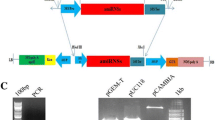Abstract
Use of siRNA is a powerful methodology to particularly knockdown the targeted genes in a sequence specific manner. The potential of siRNA can be harnessed for silencing specific geminiviral genes in papaya and tomato plant hosts, thus making them resistant to the respective viruses. The challenge is in designing exogenous siRNA which can trigger silencing of viral genes irrespective of the genetic variability in different viral isolates and at the same time the selected siRNA does not target any plant gene (off target silencing). In this study, we have designed siRNA from the most conserved regions of viral coat protein (AV1) and replicase (AC1) genes retrieved from different isolates of geminiviruses infecting papaya (PLCV), and tomato (TLCV & TLCV, Northern India), so as to give a broad spectrum resistance and efficient silencing as it is highly homology-dependent strategy. Software siRNA finder (Ambion) was used on the selected conserved sequences in order to select only those putative siRNA oligonucleotides which fulfill all the basic criteria required as per the algorithm. Finally, a cross search using BLAST was performed to confirm that the designed siRNAs do not have any homology to plant genome sequences. The putative siRNA sequences thus designed to target essential genes of geminiviruses and introduced into the plants may facilitate developing papaya and tomato crops with generic resistance to geminiviruses.





















Similar content being viewed by others
References
S. Saxena, V. Hallan, B.P. Singh, P.V. Sane, Plant Dis. 82, 126 (1998)
S. Mansoor, R.W. Briddon, Y. Zafar, J. Stanley, Trends Plant Sci. 8, 128–134 (2003)
A. Varma, V.G. Malathi, Ann. Appl. Biol. 142, 145–164 (2003)
D.C. Baulcombe, Plant Cell. 8, 1833–1844 (1996)
L. Hilje, H.S. Costa, P.A. Stansly, Crop Prot. 20, 801–812 (2001)
L. Hilje, in Abstracts: 3rd International Bemisia Workshop, Barcelona, March 17–20, 2003
J.E. Polston, P.K. Anderson, Plant Dis. 81, 1358–1369 (1997)
E.A. Bernays, Ecol. Entomol. 24, 260–267 (1999)
V.N. Fondong, J.M. Thresh, S. Zok, J. Phytopathol. 150, 365–374 (2002)
D.J. Schuster, P.A. Stansly, D.G. Dean, J.E. Polston, G.S. Swanson, in Proc. Fla. Tomato Inst., Vegetable Crops Special Series, PRO-105, ed. by C.S. Vavrina, University of Florida, IFAS, 1993, pp. 77–106
J.C. Palumbo, A.R. Horowitz, N. Prabhaker, Crop Prot. 20, 739–765 (2001)
Y. Antignus, N. Mor, R. Ben-joseph, M. Ladipot, S. Cohen, Environ. Entomol. 25, 919–924 (1996)
P. Powell Abel, R.S. Nelson, B. De, N. Hoffman, S.G. Rogers, R.T. Fraley, Science 232, 738–743 (1986)
R.N. Beachy, Semin. Virol. 4, 327–328 (1994)
G.P. Lomonossoff, Annu. Rev. Phytopathol. 33, 323–343 (1995)
H. Vanderschuren, A. Alder, P. Zhang, W. Gruissen, Plant Mol. Biol. 70, 265–272 (2009)
M.D. de Bakker, M. Raponi, G.M. Arndr, Curr. Opin. Microbiol. 5, 323–329 (2002)
E. Noris, A. Lucioli, R. Tavazza, P. Carciagli, G.P. Accotto, M. Tavazza, J. Gen. Virol. 85, 1745–1749 (2004)
S.G. Ribeiro, H. Lohuis, R. Goldbach, M. Prince, J. Virol. 81, 1563–1573 (2007)
F.J.L. Arago, J.C. Faria, Nat. Biotechnol. 27, 1086–1089 (2009)
L.D. Kumar, A.R. Clarke, Adv. Drug Deliv. Rev. 59, 87–100 (2007)
R. Vanitharani, P. Chellappan, C.M. Fauquet, Trends Plant Sci. 10, 144–151 (2005)
S.M. Elbashir, W. Lendeckel, T. Tuschl, Genes Dev. 15, 188–200 (2001)
K. Dhakar, V.K. Gupta, M.S. Rathore, R.K. Gaur, J. App. Sci. 10(16), 1781–1791 (2010)
S. Praveen, A.K. Mishra, G. Antony, Plant Cell Tiss. Organ Cult. 84, 47–53 (2006)
F. Tenllado, J.R. Diaz- Ruiz, J. Virol. 75, 12288–12297 (2001)
K. Bonfim, J.C. Faria, E.O.P.L. Nogueira, E.A. Mendes, F.J.L. Arago, Mol. Plant Microbe Interact. 20, 717–726 (2007)
A.I. Sanz, A. Fraile, J.M. Gallego, J.M. Malpica, F. Garcia-Arenal, J. Mol. Evol. 49, 672–681 (1999)
C.M. Fauquet, D.M. Bisaro, R.W. Briddon, J.K. Brown, B.D. Harrison, E.P. Rybicki, D.C. Stenger, J. Stanley, Arch. Virol. 148, 405–421 (2003)
A. Birmingham, E. Anderson, K. Sullivan, A. Reynolds, Q. Boese, D. Leake, J. Karpilow, A. Khorova, Nat. Prot. 2, 2068–2077 (2007)
S.M. Elbashir, J. Martinez, A. Patkaniowska, W. Lendeckel, T. Tuschl, EMBO J. 20, 6877–6888 (2001)
P. Pandey, N.R. Choudhury, S.K. Mukherjee, Virol. J. 6, 152 (2009)
Acknowledgments
Authors are thankful to Babasaheb Bhimrao Ambedkar University, Lucknow, UP, India and Department of Biotechnology, Govt. of India for providing infrastructural facility and financial support, respectively.
Author information
Authors and Affiliations
Corresponding author
Rights and permissions
About this article
Cite this article
Saxena, S., Singh, N., Ranade, S.A. et al. Strategy for a generic resistance to geminiviruses infecting tomato and papaya through in silico siRNA search. Virus Genes 43, 409–434 (2011). https://doi.org/10.1007/s11262-011-0649-x
Received:
Accepted:
Published:
Issue Date:
DOI: https://doi.org/10.1007/s11262-011-0649-x




